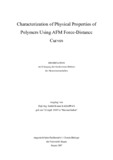Citation link:
https://nbn-resolving.org/urn:nbn:de:hbz:467-2969Files in This Item:
| File | Description | Size | Format | |
|---|---|---|---|---|
| kaliappan.pdf | 3.51 MB | Adobe PDF |  View/Open |
| Dokument Type: | Doctoral Thesis | metadata.dc.title: | Characterization of physical properties of polymers using AFM force-distance curves | Authors: | Kaliappan, Senthil Kumar | Institute: | Fachbereich 8, Chemie - Biologie | Free keywords: | AFM, Kraft-Abstands Kurven, Mechanische Eigenschaften, Kontinuumstheorien, Plastische Deformationen, AFM, force-distance curves, mechanical properties, elastic continuum theory, plastic deformations | Dewey Decimal Classification: | 530 Physik | GHBS-Clases: | UIZ | Issue Date: | 2007 | Publish Date: | 2007 | Abstract: | A novel analysis method based on Hertz theory was used to determine the mechanical properties from force-distance curves obtained over a wide range of temperatures and frequencies on poly(n-butyl methacrylate) (PnBMA) and two polystyrene (PS) samples, having different molecular weight and hence different glass transition temperature Tg. The analysis technique extends the elastic continuum contact theories to the plastic deformations and permitted to calculate the stiffness in the plastic regime of deformation, the yielding force, the parameters of the WLF and Arrhenius equations, and the Young's modulus. The Young's modulus and the shift coefficients of the polymers determined through AFM measurements were in excellent agreement with the values from DMA measurements and/or the literature values. Force-distance curves were also acquired on a model polymer blend of PS/PnBMA at different temperatures. The analysis method was used to determine the Young's modulus of PS and PnBMA away from the interface and close to the interface with a resolution of 800 nm. The differences in Tg of the two polymers resulted in different viscoelastic behavior. The modulus of PnBMA and PS was in excellent agreement with the DMA and AFM data from the measurements on individual films. The morphology of the PS/PnBMA blend was characterized using the Young's modulus of the constituting polymers. A several µm long transition region was observed in the vicinity of the interface, where the modulus of PnBMA decreased from the value on PS to the value on PnBMA away from the interface. This experiment shows the capability of AFM of surveying local mechanical properties and studying heterogeneous samples. Such spatially resolved measurements cannot be achieved with any other technique. Eine neuartige, auf der Hertz Theorie basierende Analysemethode wurde benutzt um mechanische Eigenschaften anhand Kraft-Abstands Kurven zu bestimmen. Kraft-Abstands Kurven wurden auf Poly(n-butyl Methacrylat) (PnBMA) und auf zwei Sorten Polystyrol (PS) mit unterschiedlichem Molekulargewicht und unterschiedlicher Glasübergangstemperatur Tg in einem großen Temperatur- und Frequenzbereich aufgenommen. Diese Analysetechnik erweitert die elastischen Kontinuumstheorien um plastische Deformationen und erlaubt die Steifigkeit bei plastischen Deformationen, die Fließgrenze, die Parameter der WLF und Arrhenius Gleichungen, sowie den Elastizitätsmodul zu bestimmen. Der Elastizitätsmodul und die Verschiebungskoeffizienten der Polymere, bestimmt durch die AFM Messungen, stimmen mit den Ergebnissen der DMA Messungen und Literaturwerten überein. Kraft-Abstands Kurven wurden auch bei verschiedenen Temperaturen auf einem modellhaften PS/PnBMA-Polymerblend aufgenommen. Die Analysemethode wurde benutzt, um den Elastizitätsmodul von PS und PnBMA mit einer Auflösung von 800 nm nah und fern der Grenzfläche zu bestimmen. Die unterschiedlichen Tg der zwei Polymere zeigen sich im unterschiedlichen viskoelastischen Verhalten. Die Module von PnBMA und PS stimmen mit den Ergebnissen der DMA und AFM Messungen auf einzelnen Filmen überein. Die Morphologie des Blend wurde durch den Elastizitätsmodul der einzelnen Polymere charakterisiert. In der Nähe der Grenzfläche wurde eine mehrere µm lange Übergangsregion beobachtet, in der der Modul von PnBMA vom PS-Wert zum PnBMA-Wert bei zunehmendem Abstand von der Grenzfläche abfällt. Dieses Experiment zeigt die Möglichkeit des AFM, die lokalen mechanischen Eigenschaften von heterogenen Proben zu untersuchen. Solche ortsaufgelösten Messungen können mit anderen Techniken nicht durchgeführt werden. |
URN: | urn:nbn:de:hbz:467-2969 | URI: | https://dspace.ub.uni-siegen.de/handle/ubsi/296 | License: | https://dspace.ub.uni-siegen.de/static/license.txt |
| Appears in Collections: | Hochschulschriften |
This item is protected by original copyright |
Page view(s)
608
checked on Nov 25, 2024
Download(s)
221
checked on Nov 25, 2024
Google ScholarTM
Check
Items in DSpace are protected by copyright, with all rights reserved, unless otherwise indicated.

